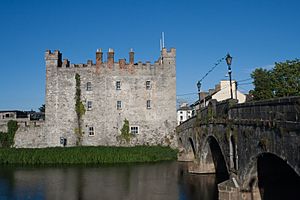White's Castle facts for kids
Quick facts for kids White's Castle |
|
|---|---|
| Native name Irish: An Caisleán Bán / Caisleán de Faoite |
|
| White Castle | |

White's Castle viewed from the west
|
|
| Type | Castle |
| Location | Duke Street, Athy, County Kildare, Ireland |
| Built | 1417 |
| Architectural style(s) | Norman, Tudor |
| Owner | Dolores Cahill |
| Lua error in Module:Location_map at line 420: attempt to index field 'wikibase' (a nil value). | |
White's Castle is a cool stone castle from the 1400s. You can find it in Athy, Ireland. It has a long and interesting story!
Contents
Where is White's Castle?
White's Castle is right in the middle of Athy town. It sits on the east side of the River Barrow. The castle was built to guard the important Crom Abú Bridge.
A Look at the Castle's History
There might have been an older building here even before White's Castle. Records from 1297 mention someone being held in the "ward of Athy." This suggests some kind of fort was already there.
Building the Castle
White's Castle was built in 1417. It was ordered by John Talbot, 1st Earl of Shrewsbury. He was the King's Lieutenant, working for King Henry V. The main reason for building it was to protect the new bridge over the River Barrow.
A man named William Scryvener was in charge of the castle from 1422 to 1426. By 1505, the castle was not in good shape. Gerald FitzGerald, 8th Earl of Kildare was asked to fix it up. More work was done during the time of King Henry VIII. In 1536, Lord Leonard Grey wrote about the castle.
In 1573, Richard Coosen, who was in charge of Athy, added a special plaque. It showed a crucifixion and was placed near the original entrance. The castle was fully finished around 1575. It was first called the White Castle or the New Castle. The name "White's Castle" came later.
The Castle's Design
The southern part of the castle was a four-story tower house. This means it was a tall, strong building used for defense.
Wars and Changes
White's Castle was very important during the Irish Confederate Wars (1641–1653). During these wars, the castle was captured by different groups many times. Owen Roe O'Neill took it in 1645. Then, the Royalists (supporters of the King) took it in 1648. Finally, Oliver Cromwell's forces arrived in 1649.
Some old writings suggest there might have been another castle. This second castle would have been on the west side of the bridge. A 1516 record mentions a castle there. A map from 1556 also shows castles on both sides of the bridge. But today, there is no sign of this western castle.
From Prison to Home
In 1730, White's Castle became the local prison. It had nine cells. In 1802, a new three-story part was added to the north side. The castle also got new battlements, which are the parts of a castle wall with gaps for defense. You can still see where the original west wall was.
After the 1798 rebellion, the castle was used to hold Irish rebels. In 1830, a small addition was built. The building then became a barracks for the Royal Irish Constabulary, which was a police force. New Sash windows were put in during 1872.
In the late 1800s, White's Castle was changed into a private home. It belonged to the Doyle and Norman families for a long time. In 2005, it was sold for €1.3 million. Then, in 2012, it was for sale again for €195,000. In 2019, the castle was sold for €450,000.
What the Castle Looks Like Today
White's Castle is a three-story tower house. It has a strong, sloped base called a base-batter. On the right side of the doorway, you can see the Earl of Kildare's family crest.
Images for kids





